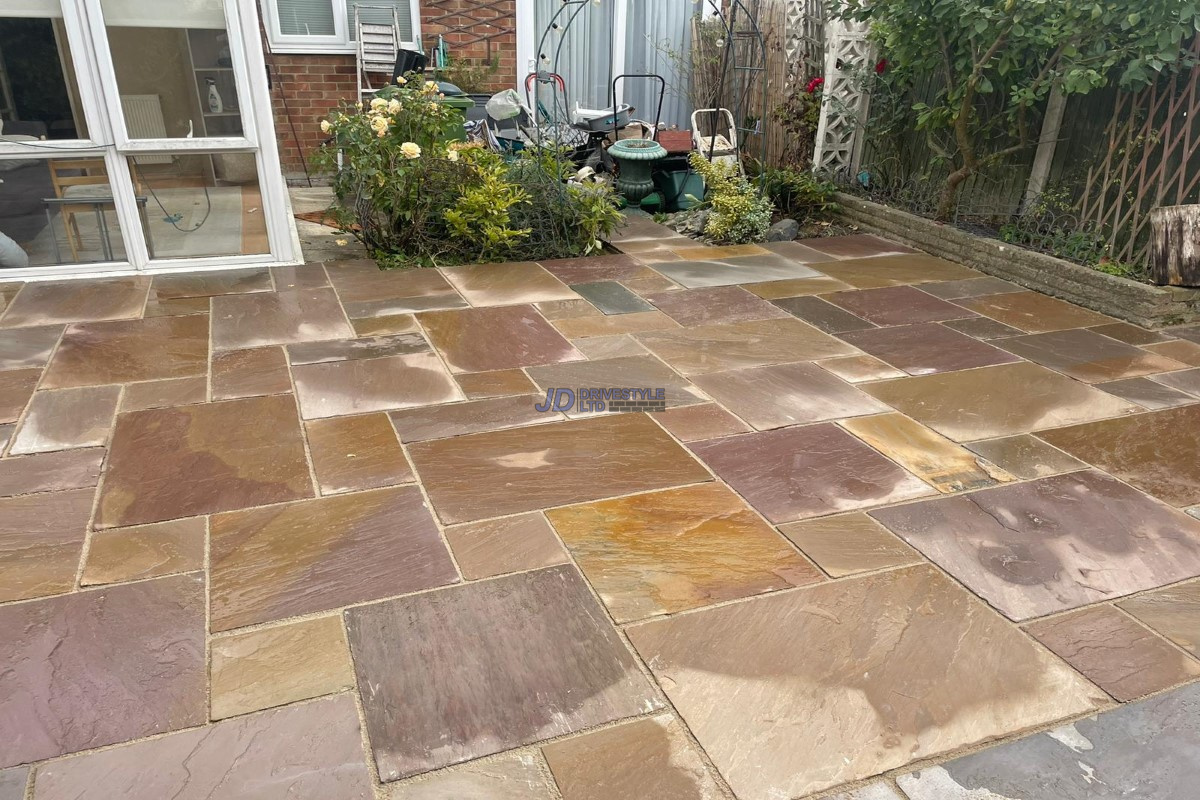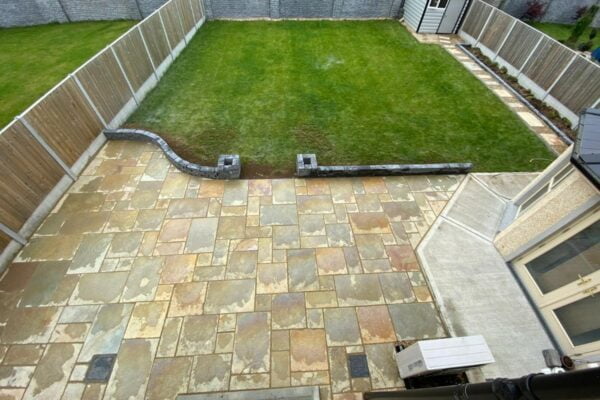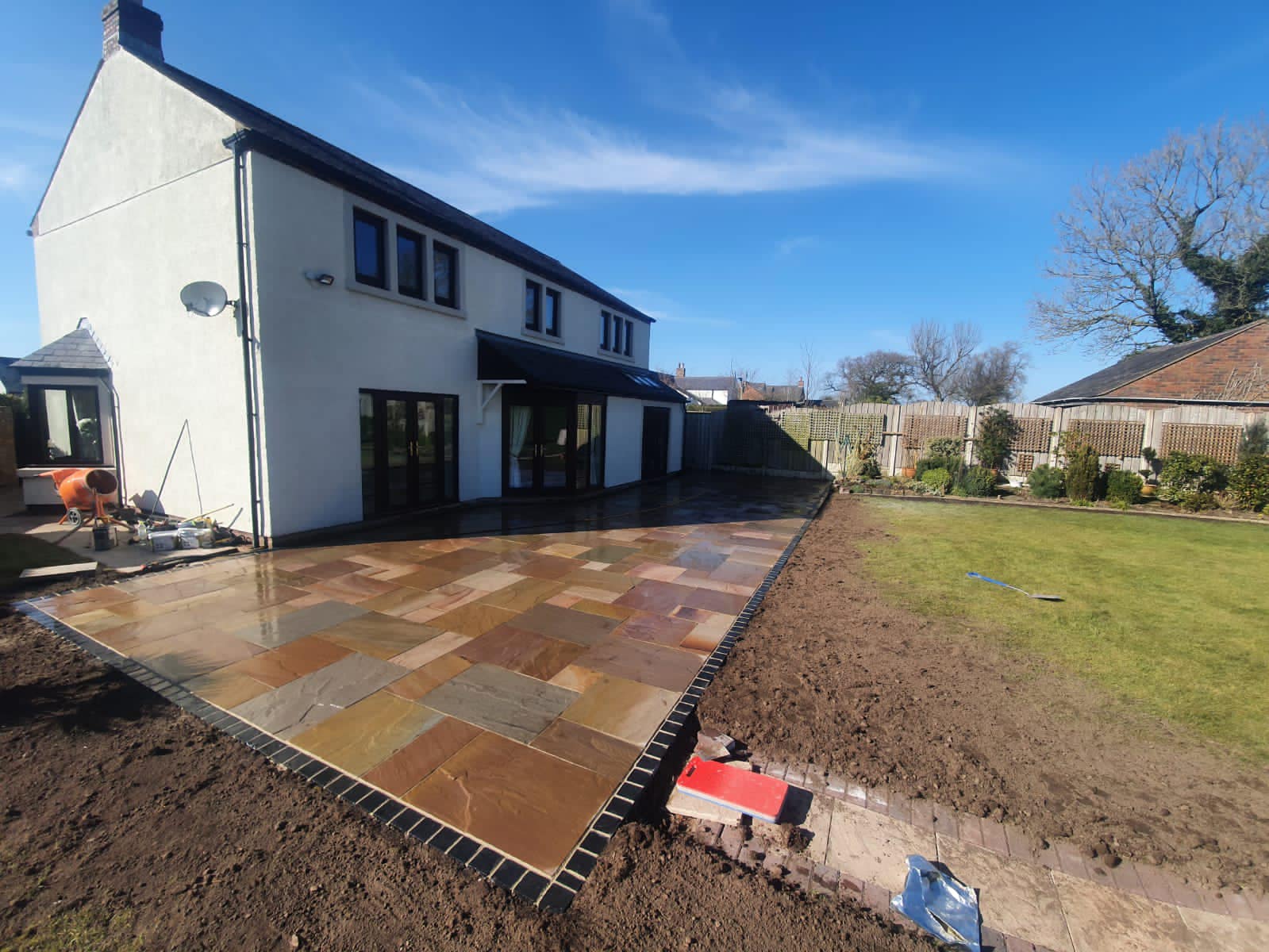Indian Sandstone & Gravel: Patio Perfection
Indian Sandstone & Gravel: Patio Perfection
Creating the perfect outdoor haven requires careful consideration of materials, design, and functionality. A patio is more than just a paved area; it's an extension of your home, a space for relaxation, entertaining, and enjoying the beauty of your surroundings. When choosing materials for your patio, Indian sandstone and gravel offer a compelling combination of aesthetic appeal, durability, and versatility. This comprehensive guide will explore the myriad possibilities of using these materials to achieve patio perfection.

The Allure of Indian Sandstone
Indian sandstone, quarried from the ancient geological formations of India, is a highly sought-after material for paving due to its unique characteristics. Its natural beauty lies in its rich color variations, ranging from warm yellows and creams to deep reds and browns, often with subtle veining and texture. This inherent variability ensures that no two sandstone patios are exactly alike, adding a touch of individuality to your outdoor space.
Beyond its aesthetic appeal, Indian sandstone boasts impressive durability. Its inherent strength makes it resistant to cracking and weathering, ensuring your patio will withstand the test of time and the elements. This robustness is especially important for high-traffic areas where the patio will endure constant use. Proper installation is crucial, of course, but high-quality Indian sandstone is naturally equipped to handle the pressures of everyday life.

Different types of Indian sandstone offer diverse textures and finishes. From tumbled and honed surfaces for a smooth, refined look to riven and flamed finishes for a more rustic, textured feel, the choices are vast. The selected finish significantly impacts the overall aesthetic and the level of slip resistance. Consider your desired style and the level of foot traffic when choosing the appropriate finish. For instance, a tumbled finish is ideal for a sleek, modern patio, while a riven finish lends itself to a more natural, traditional design.
The Versatility of Gravel
Gravel, a readily available and cost-effective material, provides a crucial counterpoint to the sophistication of Indian sandstone. It's not just a filler; it plays a vital role in enhancing the overall design and functionality of your patio. The versatility of gravel allows for creative integration with the sandstone paving, offering numerous design possibilities.

One primary function of gravel is to create a visually appealing border or pathway around the Indian sandstone paving. This creates a distinct separation between the paved area and surrounding landscaping. The contrast in texture and color adds depth and visual interest to the design. Gravel pathways, leading from the patio to other garden features, can create a sense of movement and intrigue.
Furthermore, gravel can be used to create attractive features within the patio itself. For instance, a gravel inlay within a sandstone paving design can introduce a contrasting texture and color, adding visual dynamism. This technique works exceptionally well with larger patios, breaking up the expanse of sandstone and creating interesting focal points. Careful planning and precise execution are necessary to ensure a clean and aesthetically pleasing outcome.
Beyond its aesthetic applications, gravel also offers practical benefits. It provides excellent drainage, preventing waterlogging and protecting the underlying base from damage. This is particularly important in areas with heavy rainfall or poorly draining soil. The use of gravel helps to maintain the structural integrity of the patio over the long term.

Design Ideas: Blending Sandstone and Gravel
The combination of Indian sandstone and gravel allows for endless design possibilities. The key is to balance the elegant solidity of the sandstone with the fluidity and textural contrast offered by the gravel. Here are some inspiring ideas to spark your creativity:
1. The Classic Combination: A straightforward approach involves creating a paved area of Indian sandstone surrounded by a border of gravel. This classic design is simple, elegant, and effective. The choice of gravel color should complement the sandstone, creating a harmonious visual flow.

2. Geometric Patterns: For a more contemporary feel, incorporate geometric patterns using Indian sandstone paving and gravel infills. Squares, rectangles, or more intricate designs can be created, using the gravel to define the shapes and create visual interest.
3. Mixed Material Pathways: Instead of a simple border, create meandering pathways using both materials. Sections of Indian sandstone paving alternate with gravel pathways, leading through the garden or to other areas of the outdoor space.
4. Gravel Inlays: Integrate gravel into the Indian sandstone paving itself. Create subtle or dramatic inlays, using different colored gravels to enhance the design. This technique is ideal for larger patios, providing visual interest without being overwhelming.

5. Raised Planting Beds: Use Indian sandstone to create raised planting beds within the patio area, surrounding them with gravel for contrast and drainage. This creates a cohesive design that blends seamlessly with the overall patio landscape.
6. Water Features: Integrate a water feature, such as a small pond or fountain, into your patio design. The surrounding area can be paved with Indian sandstone, with gravel used to create a gentle slope leading to the water.
7. Modern Minimalism: A clean, minimalist aesthetic can be achieved by using large, rectangular slabs of Indian sandstone with a minimal gravel border. This creates a sense of spaciousness and tranquility.

8. Rustic Charm: For a rustic feel, opt for riven Indian sandstone with a natural, weathered appearance. Use a coarser gravel to complement the texture and create a warm, inviting atmosphere.
Choosing the Right Gravel

The choice of gravel is crucial to the overall success of the design. Consider the following factors:
- Color: Select a gravel color that complements the Indian sandstone. Contrasting colors can create a bold statement, while matching colors create a more harmonious look.
- Size: The size of the gravel will affect the overall appearance and drainage. Smaller gravel is better for finer detailing, while larger gravel is more suitable for broader areas.
- Type: Different types of gravel have varying textures and colors. Consider the overall aesthetic and desired level of maintenance when making your selection.
Installation and Maintenance

Proper installation is essential for the longevity of your patio. A well-prepared base is crucial to prevent settling and cracking. Experienced professionals can ensure a high-quality installation that will last for many years.
Maintenance of an Indian sandstone and gravel patio is relatively straightforward. Regular sweeping will remove debris and prevent dirt build-up. Occasional weeding may be necessary, depending on the surrounding vegetation. For Indian sandstone, occasional cleaning with a suitable stone cleaner will maintain its appearance. Gravel can be easily replenished as needed.
Conclusion: A Patio to Treasure

A patio paved with Indian sandstone and gravel offers a unique blend of beauty, durability, and versatility. By carefully considering the design, material selection, and installation, you can create an outdoor space that will become a cherished part of your home for years to come. The combination of these materials allows for a wide range of stylistic choices, from classic elegance to contemporary minimalism, ensuring your patio perfectly reflects your personal taste and lifestyle. With meticulous planning and attention to detail, your dream patio – a haven of relaxation and entertainment – is within reach.
Gravel & Glory: Indian Sandstone Patio – A Guide to Design and Installation

The allure of an outdoor living space is undeniable. Whether it's for quiet contemplation, lively gatherings, or simply enjoying the sunshine, a well-designed patio transforms your garden into an extension of your home. And when it comes to creating a truly stunning and durable patio, the combination of Indian sandstone and gravel offers a compelling blend of beauty, practicality, and versatility. This comprehensive guide delves into the world of Indian sandstone patios with gravel, exploring design considerations, installation techniques, and maintenance tips to help you create your dream outdoor oasis.
Choosing the Right Indian Sandstone
Indian sandstone is a popular choice for patios due to its natural beauty, durability, and relatively affordable price. Its rich variations in color and texture add character and warmth to any outdoor space. Before you start, however, it's crucial to understand the different types available:

- Rajasthan Yellow: Known for its warm, golden hues and subtle variations, Rajasthan Yellow is a classic choice that complements a wide range of architectural styles.
- Kandla Grey: Offering a sophisticated, contemporary look, Kandla Grey boasts a cool, calming palette with subtle veining. It's incredibly versatile and pairs well with both modern and traditional designs.
- Autumn Brown: A rich, earthy tone that evokes a sense of rustic charm, Autumn Brown is perfect for creating a warm and inviting atmosphere.
- Kota Blue: A striking option with a deep blue-grey tone, Kota Blue adds a touch of elegance and drama to any patio. Its distinctive veining makes each stone unique.
When selecting your Indian sandstone, consider the following factors:
- Color: Choose a color that complements your home's exterior and surrounding landscape. Consider the overall style you're aiming for – rustic, modern, traditional, etc.
- Texture: Sandstone comes in various textures, from smooth and polished to tumbled and riven (naturally cleft). Tumbled sandstone offers a more rustic, aged look, while riven stone retains a natural, uneven surface.
- Thickness: The thickness of the stone determines its durability and stability. Thicker slabs are more resistant to cracking and chipping, especially in high-traffic areas.
- Caliber: Consistency in size and shape is important for a neat and professional finish. Select stones with a uniform caliber for a cleaner look.

Incorporating Gravel: Style and Functionality
Gravel serves multiple purposes in an Indian sandstone patio design:
- Drainage: Gravel provides excellent drainage, preventing waterlogging and protecting your sandstone paving from damage caused by frost heave.
- Weed Suppression: A layer of gravel acts as a barrier, preventing weeds from sprouting through the paving.
- Aesthetic Appeal: The right gravel can dramatically enhance the overall aesthetic, adding texture and visual interest to your patio. Consider the color and size of the gravel to complement your sandstone choice. Popular options include:
- Pea Gravel: Small, round gravel that creates a smooth, even surface.
- Sharp Gravel: Angular gravel that offers a more textured, rustic look.
- River Gravel: Naturally rounded gravel with variations in color and size, adding a more natural, organic feel.

The choice of gravel color should complement your sandstone. For example, a light-colored sandstone like Rajasthan Yellow might pair beautifully with a contrasting dark grey or charcoal gravel, while a darker sandstone like Kandla Grey could be enhanced with lighter-colored gravel, such as buff or cream.
Design Considerations: Planning Your Perfect Patio
Before you start digging, meticulous planning is essential for a successful Indian sandstone patio project. Consider the following:

- Size and Shape: Determine the desired size and shape of your patio, keeping in mind the available space and the intended use. Consider the flow of traffic and how the patio will integrate with the rest of your garden.
- Layout: Decide on a layout that suits your needs and aesthetic preferences. Straight lines create a clean, modern look, while curved lines offer a more organic, relaxed feel.
- Accessibility: Ensure the patio is accessible for everyone, including those with mobility limitations. Consider the slope of the ground and the need for ramps or steps.
- Positioning: Consider the sun's path and prevailing winds. Choose a location that offers ample shade during the hottest part of the day and avoids direct exposure to strong winds.
- Surroundings: How will the patio integrate with the surrounding landscape? Will it connect to other outdoor features like a lawn, flowerbeds, or water features?
Installation: A Step-by-Step Guide
Installing an Indian sandstone patio with gravel requires careful planning and execution. Here's a step-by-step guide:

- Site Preparation: Clear the area of vegetation, debris, and topsoil. Dig out the area to the required depth, accounting for the thickness of the gravel base and the sandstone paving.
- Base Layer: Create a stable base by compacting a layer of hardcore or MOT Type 1 sub-base. This provides a solid foundation for the gravel and sandstone.
- Gravel Layer: Add a layer of gravel, typically 50-100mm deep, ensuring it's level and compacted. This provides drainage and weed suppression.
- Sand Bedding: Spread a layer of sharp sand over the gravel, creating an even bed for the sandstone paving.
- Laying the Sandstone: Carefully lay the sandstone paving on the sand bed, ensuring that the stones are level and spaced evenly. Use a rubber mallet to tap the stones into place.
- Grouting: Once the sandstone is in place, fill the gaps between the stones with a suitable grout, such as polymeric sand. This prevents weed growth and stabilizes the paving.
- Compaction: After grouting, compact the area to ensure the stability of the patio.
- Final Touches: Sweep away any excess grout and add any finishing touches, such as edging or planting.
Important Note: If you lack experience in groundworks and paving, it's advisable to hire professional landscapers or paving contractors for the installation. They have the expertise and equipment to ensure a high-quality, long-lasting result.
Maintenance: Keeping Your Patio Looking Its Best

Maintaining your Indian sandstone patio is relatively straightforward:

- Regular Sweeping: Regularly sweep away leaves, debris, and dirt to prevent build-up.
- Weed Control: Address any weeds that manage to sprout through the gravel or grout promptly.
- Cleaning: Clean the patio periodically using a mild detergent and a soft brush or pressure washer. Avoid using harsh chemicals that could damage the sandstone.
- Sealing: Consider sealing your sandstone to protect it from staining and weathering. A sealant will enhance the longevity of your patio.
- Repairing Damage: Repair any cracked or damaged stones promptly to prevent further damage.
Conclusion: Embracing the Beauty of Gravel and Sandstone


A patio paved with Indian sandstone and gravel is a beautiful and practical addition to any home. By carefully considering design aspects, choosing the right materials, and following proper installation and maintenance practices, you can create an outdoor space that you'll enjoy for years to come. The combination of the rich colors and textures of the sandstone, combined with the functional and aesthetic benefits of gravel, will create a truly stunning and inviting outdoor retreat – a testament to the enduring appeal of "Gravel & Glory." Remember to consult with professionals for design and installation if you are unsure about any aspect of the project. Enjoy the process of creating your perfect outdoor space!

